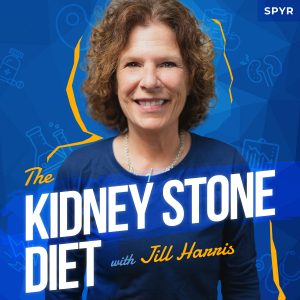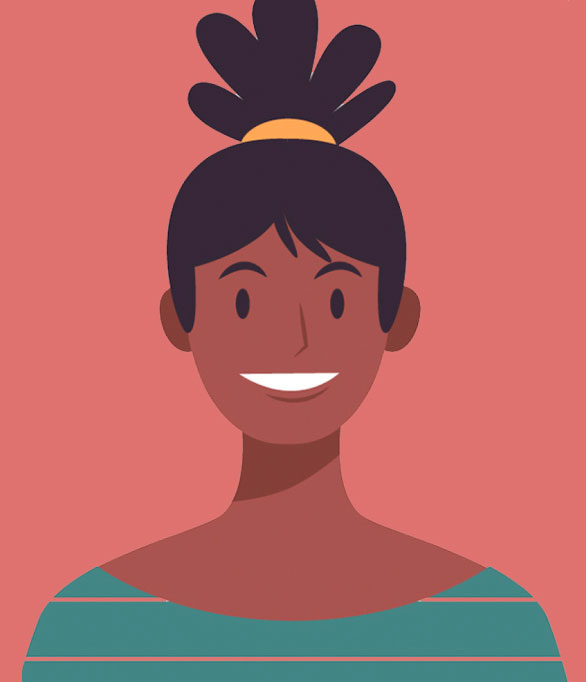This week, Jill talks about the connection between spices and kidney stones.
Jeff Sarris: Welcome back to the Kidney Stone Diet podcast, the show about reducing your kidney stone risk and living your best life. I’m your host and fellow student, Jeff Sarris.
Jill Harris: And I’m Jill Harris, your kidney stone prevention nurse.
Jeff Sarris: It’s always fun doing the intro. Never know what we’re gonna get.
Jill Harris: Well, the last episode, I just didn’t even speak at all when it was my turn. This episode, I bit the gun, or whatever you say. I can hear my mother saying right now, “Boy, she’s been doing enough of these. Almost 100 of them and she still doesn’t even know who she is, or where she is!”
Jeff Sarris: Isn’t it crazy? 86! This is the 86th episode. It’s 87 weeks because we missed one week because just we had things come up that we couldn’t get to it that week. But yeah, it’s wild. I really want to do something for number 100. I think it’ll be fun.
Jill Harris: I know. We’re gonna do something. I think we we can do something. We could do location, we can give away something, people, we’re gonna celebrate, somehow. Jeff and I have been too busy to figure that out, but we are going to do something. We will do something, for sure.
Jeff Sarris: So, this week, we’re doing a another specific question. It is going to be about what spices cause kidney stones. But before we get there, if you have any questions that we haven’t answered, or even if we have answered on a previous episode, but you want them tailored to your situation, the number is 773-789-8763, and we’d love to feature you on a future episode. We’ve mentioned for the past couple, but if you haven’t subscribed, we would love to have you subscribe to the channel because it really helps. Hit that little bell to get notified when we post. We post every Tuesday.
Who knows in the future, if maybe we’ll be adding anything else depending on all the different ideas and plans that we have. But, for now, it’s once every Tuesday, so you can expect that. If you hit that little bell, you won’t be inundated by notifications or anything, but it helps a lot because it helps us reach more people. And the sooner the videos are watched on Tuesdays, it just helps for the algorithm. I hate to bring up the algorithm, but it’s true. It’s how we can reach more people because it’s seen to be successful early on. But, if you haven’t subscribed yet, it would mean a lot. And with that, I would say, why don’t we just dive into the episode! Dive into the topic.
Jill Harris: Okay, let’s do it! So, what spices cause kidney stones? Well, here’s what I will say about that. So, turmeric has been–turmeric and cinnamon are two spices that are known to increase the risk of kidney stones only because of the oxalate content. So those two things have been–I think it’s a PubMed or NIH study, whatever. It’s researched and studied. We know that cinnamon and turmeric will increase your oxalate levels. So if you’re overdoing it, I mean, you know, people from India or people who are in a culture that are eating a lot of curry, and turmeric, and all these foods every single day, they can have kidney stones.
How Much Calcium is Enough?
They also are not doing other things, though. Maybe they’re eating too much salt and not drinking enough fluids, so it’s not just those things, but if you’re overdoing those two spices in large amounts on a daily basis, you can certainly be increasing your oxalate. Along with, of course, not getting any calcium. I always say this, I’ve never worked with an adult in 23 years that says to me, “Shut up, Jill. I get plenty of calcium.” No one has said that to me in 23 years.
Most of us do not get enough calcium, and how much calcium we’re supposed to get is 1000 for men and women milligrams per day, 1000 milligrams of calcium per day. And, for postmenopausal women, up to 1200. When I say a goal, like 1000 for men and woman, and 1200 for postmenopausal women, that doesn’t mean 5000. It doesn’t mean more than it means up to. So, even if your doctor says, “Well, you’re postmenopausal, you shouldn’t be getting 1200 milligrams of calcium,” even if you’re getting 1100, these labels are not precise. So I just don’t want you to go over because calcium is the best absorbed thing in the world, so you don’t want excess in your urine.
Let’s Talk Cinnamon & Turmeric
Okay, back to the regularly scheduled programming: spices. So, if you’re overdoing cinnamon, and tumeric–and overdoing is just that–cinnamon all the time. If you’re on Spotify, know that I’m shaking my hand up and down, up and down, okay? Too much of it. Does that mean you can never go out for foods that have turmeric in it? No, it does not mean that. Does that mean you can’t put a little cinnamon, you know, on some toast? No, it does not mean that. It does not. It means you do not want to overeat.
Some people say, “Hey, I’ve read that pepper is high in oxalate, so I have not used any pepper since 1942.” Well, again, people, it’s about a portion game. Portion, not perfection. So, if you’re eating a cup of ground pepper a day, you might have a problem. If you’re just like, whoosh, whoosh, whoosh on your food, it’s not going to be a problem. Typically, what I find with the oxalate thing is people get overly–most of my day with private patients or in a kidney stone prevention course, is me telling patients there’s so much more you can eat. You’re restricting yourself way too much.
So, of course, you can have a dish that has turmeric in it, if you’re going out to eat, but you can have it all the day in any amount you want. Okay, of course, you can have cinnamon, sometimes, if you’d like that. I put that in my coffee grounds to add a little flavor, a little pep in my step in the morning. So, sometimes I will and I have kidney stone family members, so I don’t want kidney stones to be added to my medical list. I definitely follow the things I ask you guys to do.
I’m not too concerned about spices. I’m not too concerned about herbs, as long as you use everything within moderation. So don’t use the two highest things like cinnamon and tumeric over, and over, and over. Get your calcium needs met every day. Of course, you can use pepper. You can use all herbs when you’re just using a little bit in your food. The first word that came to my mind is what my patients always say, they always say this: “My husband says I’m being overly dramatic.”
Well, I don’t think anybody’s being overly dramatic because if you’ve been hit with a kidney stone, and the pain that suddenly comes on, and the surgeries that you have to have, I don’t think anybody here who has had a medical condition is being dramatic. I’d rather you edge on the side of dramatic than not giving a damn. But let’s change that judgmental word “dramatic” and put “cautious.” My point is: you don’t have to be as cautious as you think you do.
Once you get educated, it’s not just about the “Yes’” and “No’s” in the kidney stone world. So, most foods are absolutely allowed on the Kidney Stone Diet. It’s just that the foods you have to be cautious with, be cautious with. Don’t eat them over and over. The couple of foods that we really take away are spinach and almonds. There’s a few, also, that are really high in oxalate, but they’re less eaten so I don’t go crazy about them. And there’s a list of high oxalate foods to avoid at kidneystonediet.com, the start page.
What About Herbs?
But, really, guys, as far as herbs are concerned, use them in your cooking. I want you to experiment with herbs because we’re trying to teach you to lessen salt. I have the Kidney Stone Diet meal plan and in my recipes, I rarely use salt. But you’ll see in my recipes where all the oxalate, all the salt, all the added sugar, all the goals of the Kidney Stone Diet is figured out for you already. I’ve done that. And, on each recipe, you’ll have all that. The reason I’m bringing the meal plan subscription up is because you will see I use a lot of fresh herbs. “They’re expensive, Jill!” So are kidney stones.
Once you lessen the sodium in your foods, you’re going to want to use fresh herbs for flavor or dry doesn’t have to be fresh. I like treating myself with fresh herbs because they’re delicious. And they add so much flavor to my foods. So, you know, use herbs to lessen the salt just don’t use the same ones over and over, and the ones that we really don’t like, the turmeric and the cinnamon, okay? Otherwise, I’m using parsley, oregano. I’m using all those herbs. We’re not dumping cups of it in there, people. Use it. Enjoy! Just pay attention to how many times a week you’re having turmeric and cinnamon. Don’t go overboard, either. So, how’s that, Jeff?
Jeff Sarris: Yeah, I definitely fell into the overboard on turmeric a while ago, not too long ago. Also, it wasn’t actually in food. It was a supplement approach because there is a–
Jill Harris: Oh, thank you for bringing that up! Yes, thank you!
Jeff Sarris: Yeah, there’s a squeezable jar–err, a squeezable thing–that, first off, tastes like candy. It is turmeric with like orange essence in it and it’s like a, not a gel, but it’s like a thicker liquid. I had come across something about the inflammation and how turmeric can really help with inflammation and things. I was like, “Oh, this will be great!” So, I was doing little shots about every day and I completely stopped and tossed it as soon as we met because I was like, “Oh, that is very much not good.” Because it was extremely concentrated and it was supposed to be really good for inflammation, which it very well could be very good for inflammation, but also not good for other things.
Jill Harris: God bless that you brought that up! I truly am nothing without you. God bless that you brought that up because that is–and, again, one year later, all the turmeric capsules are on Home Goods reduced section. People are bored of that. They’re waiting for the next best thing. So, yes, studies show, and a lot of doctors will say, “Take these turmeric capsules. They’re going to decrease inflammation.” So, yes, sometimes in life–something that we in the kidney stone world is saying, “Hey, watch this! Limit this!”can have other properties that are really good for us. Thank you so much, Jeff for reminding me.
So, those turmeric capsules, people, again, just like Jeff did–inflammatio. I don’t want that, so I’m going to take a whole jar of these pills. Next thing you know your oxalate’s high. You want to decrease inflammation without having to take nothing. Lower your added sugar! That’s it! Eat more healthy foods, within moderation. Get rid of the salt! Get rid of the sugar! Eat less sugar! On the Kidney Stone Diet, and the American Heart Association, all kinds of people–the sugar goal for us as a country, for we as a country, 25 grams of added sugar for women, 38 grams of added sugar for men. It’s 37.5, but what the hell? No one likes decimals, so I just add up to 38 and give ’em it. So, you want to decrease inflammation? Move your body. Eat the Kidney Stone Diet way because it’s just a healthy diet and you won’t need no capsules.
Jeff Sarris: Yeah, definitely! Yeah. And I think that’s a really good–
Jill Harris: People just unsubscribed today! “Unsubscribe, Paul, unsubscribe!”
Jeff Sarris: Yeah, we just balanced out all the people who subscribed at the beginning have unsubscribed now. So no, no, but I mean–
Jill Harris: Don’t eat no sugar. Because people want to take pills! It’s easy! Let’s take the pill. We all want a quick fix. So, instead of getting something, or eating foods that create things that now we got to do something else, take away the foods that are creating the inflammation, if it is food-induced, and ditch the pills. Keep your nickels in your pocket. Put those nickels towards buying healthier foods.
The annoying thing, too, is a lot of healthy foods can be a little bit more expensive, right? But I don’t know where they could and I don’t know where else, though, you want to spend a few extra pennies. Because pay for it upfront. Pay, pay for it upfront, healthier foods, so you’re not letting surgeries and all those things take away your money later. It’s really important. We’re talking very little money, too, at the end of the day.
Jeff Sarris: For sure! We’re talking about long term health. And, it’s important to think about what we’re doing, what we’re putting in our bodies, how we’re treating our bodies, how we are taking care of ourselves. I think that’s a good place to wrap this week. If you have a question that you would like answered on the show, the number is 773-789-8763, and we would love to feature your voice on a future episode.
And, if you haven’t already subscribed, it would mean the world if you did hit that “subscribe” and hit that little bell. I don’t mean to sound like a broken record. I feel like I’ve brought it up a lot lately, but it means a lot. It goes a long way. If you are looking for a deeper dive into things, head over to kidneystonediet.com, where you can find the free materials at kidneystonediet.com/start, but also the meal plans and the prevention course and all of the premium content that’s there, including the urine analysis, which is a one-on-one consult with Jill where she helps you break down what you got from a urine analysis report. But yeah, I think that’s a good spot to wrap and–
Jill Harris: Oh, wait, Jeff, I have one more thing! I want the question of the day! How many of you took–just like Jeff did, because you thought it was going to help with inflammation–how many of you thought that whatever, whether it was a superfood, a special pill, and what did you do that you think caused your kidney stones that you didn’t know about? Write it in the comments so we can talk about it!
Jeff Sarris: So, thanks again for listening, and we will see you next time!
Jill Harris: Thanks, guys! Bye!














Leave a Reply